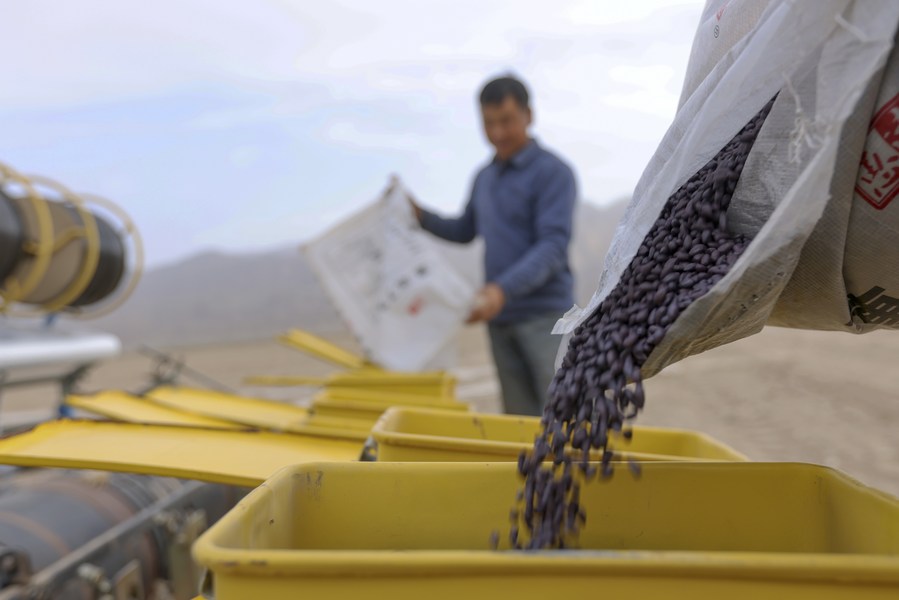Seed technology drives cotton mechanization in China's Xinjiang


URUMQI -- In Northwest China's Xinjiang Uygur autonomous region, the cotton farming mechanization process starts at the very beginning, namely with the development of seeds.
As the largest cotton-producing region in the country, Xinjiang has achieved a remarkable mechanization rate of over 97 percent in cotton farming. Through the popularization of large machines and by leveraging cutting-edge technologies such as AI-assisted breeding, biotechnology-based breeding and gene editing, agronomists and scientists are continuously developing and selecting more high-quality cotton seed varieties suitable for mechanical harvesting.
"In 2024, we sold over 2,200 tonnes of cotton seeds domestically, all for mechanical harvesting, covering 1.22 million mu (about 81,333 hectares)," said Luo Cheng, head of the R&D center at a seed company in Xinjiang.
The company has developed six cotton varieties, all designed for mechanical harvesting. "Our seeds are also very popular abroad. Last year, our overseas sales reached 930 tonnes," Luo added.
Tahir Peyzulla, a cotton farmer in Luntai county, explained the impact of these new seeds.
"Older varieties had loose plant structures and uneven maturity, making mechanical harvesting inefficient. But since we started using the new variety in 2016, the efficiency of mechanical harvesting have improved significantly," he said, while adding that he expects a bumper cotton harvest of around 500 kg per mu this year.
Jiang Hui, general manager of the cotton research institute at another seed company, highlighted the challenges of traditional cotton varieties in mechanical harvesting -- including poor adaptability, fiber fragility and incompatible field management.
"After more than a decade of research, we've achieved a technological breakthrough in mechanical harvesting varieties," Jiang said. "We've developed new varieties with compact plant structures, concentrated boll opening and easy detachment of boll stalks, using molecular breeding and gene editing. These new varieties have significantly improved the efficiency of cotton pickers, with a one-time harvest rate surpassing 90 percent."
"From the very start -- selection of seeds suitable for mechanized farming, we are laying the foundation for full mechanization of cotton production," noted Liu Tao, deputy director of the agricultural mechanization management office under the regional department of agriculture and rural affairs.
Xinjiang produced nearly 5.69 million tonnes of cotton in 2024, accounting for 92.2 percent of China's total output and hitting a record high, data from the department showed.
Notably, traditional cotton seeds have not only seen technological breakthroughs, but the mechanized harvesting of long-staple cotton, known as the "king of cotton," has also made great progress.
Long-staple cotton, highly valued for its longer fibers, is one of the world's finest cottons, with a silk-like luster and a cashmere-like feel. But mechanical harvesting of long-staple cotton used to be inefficient due to the low position of fruiting branches, necessitating manual picking.
Mechanical harvesting requires at least a 15-cm node-height of the first fruiting branch above the ground, while that of previous long-staple cotton varieties was only about 9 cm, explained Tian Liwen, a researcher at the Xinjiang Academy of Agricultural Sciences.
After nearly a decade of research by the academy's institute of economic crops, the "Xin 78" variety, developed for mechanized harvesting, achieved full mechanized harvesting in 2021 with a yield of 511.5 kg per mu. It has since become the leading variety of long-staple cotton in Xinjiang.
The new variety has not only extended node-height to 17 cm, but also addressed other issues associated with old varieties -- such as small cotton bolls, large leaves and poor response to defoliant sprays, that may affect output, Tian added.
Despite the summer heat, seasoned grower Tursuniyaz Turek still maintains his morning ritual -- a leisurely walk through his vibrant green cotton fields in Awat county in Xinjiang's Aksu prefecture.
"These days it's more about taking a look than actual work," he remarked, brushing a hand along the thriving plants. "With the new cultivars, machines take care of almost everything from plant management to harvesting. My role has become more about supervision than sweat," he said.
- Deep-sea AI tool powers up marine research, poised for global use
- Tech and sports unite at National Games
- CNS Fujian's home base is the Sanya Military Port, the Chinese Navy says
- Xi urges deepening reform, opening-up during Guangdong inspection tour
- Xi attends carrier's commissioning
- Xi inspects Meizhou in South China's Guangdong




































